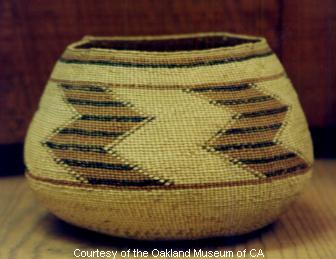
Basket for storing acorns, which were a staple food for the Hupa and Yurok.
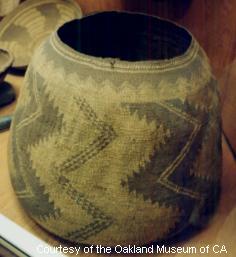
Hupa tray for drying salmon
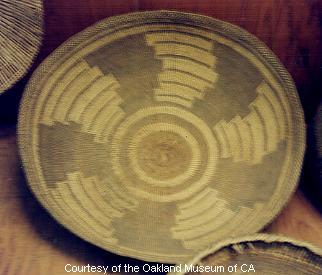
Salmon serving tray
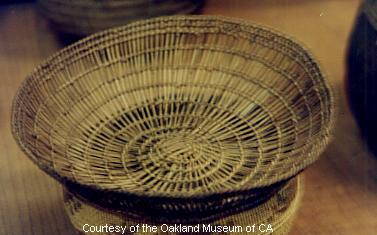
A Hupa woman's dress hat.
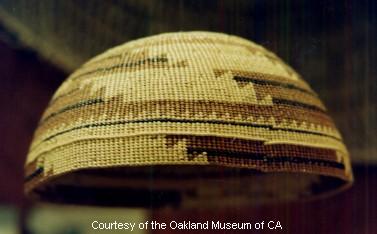
A woman's everyday hat.
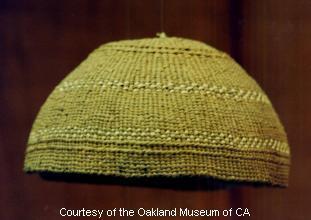
Baby carrier and cradle
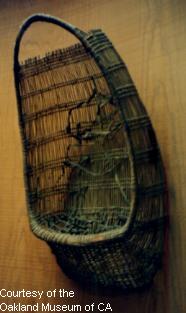
THE AREA
The Hupa and the Yurok live in the coastal mountains of Northern California between what is now Eureka and Crescent city. The Hupa Valley is 8 miles long and the Trinity River runs through it to join the Klamath River at the base of the valley. The river is a large part of their culture. They still think in the traditional “upstream” and “downstream” directions. The Hupa Valley is very isolated and creates a place where the past and the present meet. Even though the Hupa people have jobs now and they have forgotten their language they still have baskets and the materials to make them all around their houses.
In the Hupa Valley is a plentiful area. In the valley there are cottonwood, willow, alder, manzanita, pine, yew, Douglas fir and oak trees. As for the fauna, salmon, eels, sturgeons, trout, otters, hawks, eagles, elk, deer, grizzlies and small brown bears are found in the area. Of this the Hupa usually ate acorns, deer and salmon, all of which were very plentiful. [6]
LIFE IN A HUPA VILLAGE
In the center of the Hupa Valley stood the Takimildin, which means “place of the acorn feast.” The spiritual leader was chosen at that site, which was the spiritual center of the valley. It was also the site of three Hupa ceremonies. The villages in the valley were each made up of a family group. Therefore people in the same village never married each other. Within a village everyone worked toward a common goal of keeping the village running smoothly. Even distant cousins were spoken of and treated as brothers and sisters.
Each family built a xonta. The xonta was a 20-foot structure that was partially underground. The women and the young slept in the xonta at night. Also it was used to store food, tools and clothes. The structure was made of cedar boards and a small round door on the right of the front of the xonta kept the bears out. Inside there was a sunken pit in the center where the fire burned. The men slept in the taikyow, or sweathouse. After dinner the men would retire to the sweathouse to smoke, talk and sleep.
The babies in the village were watched by many members of the village, but mostly by the mother. When the baby was no longer nursing the grandparents took over primary care of the child and taught him or her the ways of the village and the beliefs of the tribe.
Each age group of within the Hupa had duties to the village, the family and the valley. At age 9 children were separated, the boys went with the men and the girls went with the women. The boys learned to gather firewood, hunt and fish. When learning to hunt they started with small game and as the got better they moved up to larger prey. The Hupa also used dogs to hunt. When the dogs were not being used to hunt they were used to guard the women and children from bears. The boys also learned to prepare the animal skins to be used for clothes, robes, leggings, quivers and pouches. Fishing was another vital skill that young boys learned. The Hupa used traps, nets, baskets, harpoons, hook and line methods and bows and arrows. The boys also learned how to make hunting tools.
The young girls learned what plants could be eaten, used as medicines and woven with. They were taught to gather fruits and nuts, care for children, make clothes and tools, and how to make baskets. The women were also responsible for preparing food, such as acorns, an involved process. Acorns had to be ground and soaked to leach the bitterness out of them. The women also prepared the game that was brought back from the hunts and dried it for use in the winter.
Some of the women in the tribe were trained to be doctors. They trained for many years to learn how to diagnose, gather the appropriate plants and treat illnesses.
Yurok were costal people and culturally very similar to the Hupa. Although they spoke different languages they traded goods that could only be gathered or made in their respective areas. The Yurok traded seaweed, ocean fish and dugout redwood canoes with the Hupa. Also the Yurok and Karok, who live north of the Hupa, attended Hupa ceremonies. [7]
CEREMONIES AND RITUALS
There were many rituals and ceremonies around the issue of pregnancy and childbirth. When a woman was pregnant she would not eat any meat. This made for a smaller child and therefore an easier childbirth. Also, when woman gave birth, she would give birth in a shelter called a mintc. The woman would stay in the mintc for ten days. After ten days some of baby’s hair would be burned signifying that the baby was no longer a spirit.
When a girl became a woman the flower dance was performed. The girl spent ten days purifying herself by fasting, praying and bathing. The men of the village sang and danced for her and the women reminded her of her new responsibilities. After the ten days she was an adult in the village.
When a man from another village wanted to marry a woman of the village, the man offered her father a payment for her. If her father accepted then they were married. For the marriage feast the girl’s village brought many gifts to the man’s village. The feast went on for three days. On the last day the groom’s family gave gifts to the woman’s family.
When a death occurred the grave was guarded for five days. The relatives of the deceased cut their hair short to show their grief and a widow would cut her hair very short. Once the person had died no one spoke his or her name. It was considered an insult to speak the name, so people would refer to the one who had passed away in indirect ways. A child might refer to a parent who had passed away as “the one I resemble.”
Large ceremonies were held for the first salmon and the first eel of the year. In the fall the Hupa built a dam across the Trinity River for fishing. Anyone who helped build the dam could fish off of it.
At the first acorn ceremony the medicine woman and up to five other women prayed for good fortune, good health and a large acorn crop. This ceremony also involved a great feast and a celebration where many different games were played. The women played dice games with mussel shells. The men played a guessing game with sticks. The strongest men played “sticks” which is a cross between hockey and wrestling. The men also wrestled and had archery contests. [7]
BASKETRY
Weaving a basket was a very time consuming but incredibly important process. Gathering materials was done almost year round depending on when was the best time to harvest different materials. The Hupa planted hazelnut around their houses to make harvesting easier and to ensure that they had this important element. Hazelnut was harvested in April and May. Each year the women burned the ground where they planted the hazelnut to ensure that it grew in straight. Sour grass and straw grass are greenish yellow. They were picked from April to June. The best sour grass and straw grass were picked from a spot in the shade because they were moister and less bleached by the sun. Conifer roots were used for the weft. The conifers that roots were harvested form were coastal redwoods, juniper, digger pine, willow, cottonwood, red alder and spruce. These could be dug anytime, but were often dug in March. Maidenhair fern were harvested form the coast between June and October. Woodwardia fern is like maidenhair fern and is found in moist shady soil. It is often picked in the fall and winter. White alder bark was used for red dye.
The weaving is always done clockwise and the materials have to be kept damp while they are being woven with. To weave the basket two hazelnut sticks are lined up butt ends together. They are wrapped together to make one long stick. This is repeated with four more sticks that are place parallel to the first two. Then six more sticks are prepared in the same fashion and placed perpendicular to the first set. This creates a square base for the basket. Then the twining is done by weaving another material around the “spokes” in a clockwise direction. Additional spokes are added as the basket grows. At the end the spokes still poking up past the basket are simply cut to be flush with the last twining. The weave is tight enough to keep from unraveling.
As for the designs on the baskets, old traditional designs are encouraged. These are not too elaborate, they contain good spacing and have large areas of one color. One favorite design is of flint or an “oblique parallelogram” [6]
To add designs different color rods were woven around the spokes. Some of these different color rods could be collected while others were dyed using natural dyes. White bear grass tips could be used for white or yellow designs. Maidenhair ferns are used for black designs. Oregon grape root and lichen were used to make a yellow dye. Alder bark and giant fern were used to make reddish brown dyes. [7]
HUPA BASKETRY
Typical Hupa basket, simple design, twined.
Basket for storing acorns, which were a staple food for the Hupa and Yurok.
Hupa tray for drying salmon
Salmon serving tray
A Hupa woman's dress hat.
A woman's everyday hat.
Baby carrier and cradle